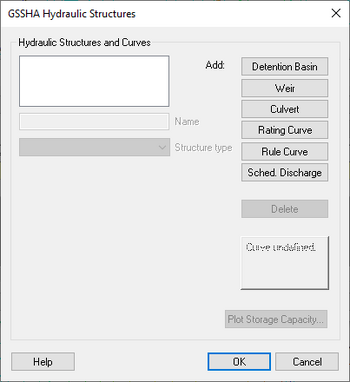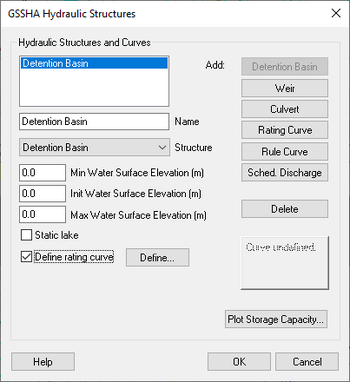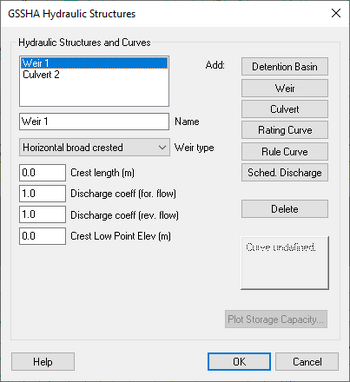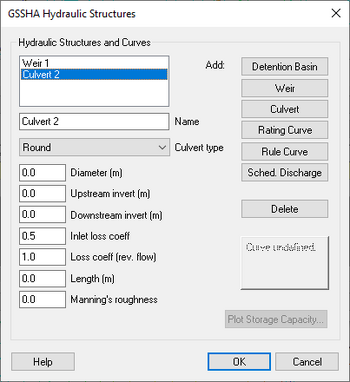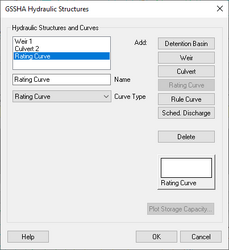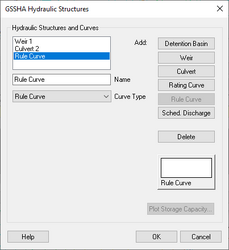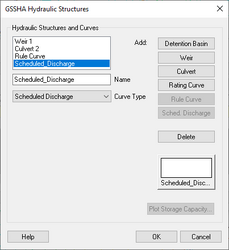WMS:GSSHA Hydraulic Structures
The GSSHA Hydraulic Structures dialog allows for defining hydraulic structures which exist in the GSSHA stream network. This dialog is accessed by clicking the ![]() button in the Hydraulic structures column of the feature nodes Properties dialog.
button in the Hydraulic structures column of the feature nodes Properties dialog.
Link-break type nodes on GSSHA stream arcs (trapezoidal or cross-section) are used for defining known points of control and modification of the stream flow by in-stream hydraulic structures such as weirs and culverts. Hydraulic structures are represented as a separate link in the stream network in GSSHA. As such, if a feature node does not exist where a hydraulic structure exists, a feature node (with the link-break type) must be placed there.
Main Options
There are four main types of hydraulic structures: detention basins (lakes), weirs, culverts, and implicit defined structures. Any number of lakes, weirs, culverts, and/or curves may be specified together, but with only one instance of each curve type allowed.
The Add options include:
- Detention Basin – Only one can be defined per node or point.
- Weir – Multiple weirs can be defined per node or point.
- Culvert – Multiple weirs can be defined per node or point.
- Rating Curve – Only one can be defined per node or point.
- Rule Curve – Only one can be defined per node or point.
- Sched. Discharge – Only one can be defined per node or point.
Each type of hydraulic structure has different settings, as detailed below. In addition, the following buttons appear in the dialog:
- Delete – Immediately delete the selected structure or curve.
- Help – Takes you to this page.
- OK – Saves the structure and curve data added to the list in the top left and closes the GSSHA Hydraulic Structures dialog.
- Cancel – Closes the GSSHA Hydraulic Structures dialog without saving the structure and curve data added to the list in the top left of the dialog..
Detention Basin
It is simpler and recommended that the user define a lake as a detention basin on a hydraulic structure at a point in a GSSHA model instead of using a polygon. See the page on how to define GSSHA feature polygons for more information about defining detention basins and lakes in a GSSHA model. Only one detention basin can be created for each node or point.
The options for detention basins include:
- Name – Enter the desired name for the detention basin. The default value is "Detention Basin".
- Structure – A drop-down list of types of structures. "Detention Basin" is the default structure.
- Min Water Surface Elevation – A decimal value in meters giving the minimum water surface elevation of the detention basin.
- Init Water Surface Elevation – A decimal value in meters giving the initial water surface elevation of the detention basin.
- Max Water Surface Elevation – A decimal value in meters giving the maximum water surface elevation of the detention basin.
- Static Lake – Turn on to indicate a static lake. Lakes can be specified as static features on the overland and channel. This can be computationally expedient because the calculations required for lakes taking and releasing overland cells and channel nodes is removed. The lake is assumed to occupy the maximum lake extent specified.
The Min Water Surface Elevation, Max Water Surface Elevation, and Init Water Surface Elevation must still be specified. All cells below the Max Water Surface Elevation become lake cells and any water that enters the cell through any mechanism will be added to the lake. If the lake area is actually highly variable, then the accuracy of this approximation may suffer. - Define rating curve – Enables the Define... button which opens the Detention Basin Rating Curve dialog.
- Plot Storage Capacity...
Weir
A weir is a barrier across the width of a river that alters the flow characteristics of water. The options for weirs include:
- Name – Enter the desired name for the weir. The default value is "Weir" followed by a WMS-assigned integer.
- Weir type – A drop-down with the following options:
- "Horizontal broad crested"
- Crest length – The length of the weir crest (bottom edge of the notch) where water begins to flow through. A decimal number in meters.
- Discharge coeff (for. flow) – Ratio of actual discharge to ideal discharge. A decimal number.
- Discharge coeff (rev. flow) – Ratio of actual discharge to ideal discharge. A decimal number.
- Crest Low Point Elev – Elevation of the crest above the model elevation. A decimal number in meters.
- "Infinite sag vertical curve"
- Steep slope – Grade of the steepest approach. A negative decimal number in m/m.
- Shallow slope – Grade of the shallowest approach. A positive decimal number in m/m.
- Discharge coeff (for. flow) – Ratio of actual discharge to ideal discharge. A decimal number.
- Discharge coeff (rev. flow) – Ratio of actual discharge to ideal discharge. A decimal number.
- Crest Low Point Elev – Elevation of the invert. A decimal number in meters.
- Crest length – Length of the vertical curve. A decimal number in meters.
- "Horizontal broad crested"
Culvert
A culvert is a structure that allows water to flow under a road, railroad, trail, or similar obstruction from one side to the other side. The options for culverts include:
- Name – Enter the desired name for the culvert. The default value is "Culvert" followed by a WMS-assigned integer.
- Culvert type – A drop-down with the following options:
- "Round"
- Diameter – The diameter of the inside of the circular pipe. A decimal number in meters.
- Upstream invert – Lowest point on the inside of the culvert at the upstream end. A decimal number in meters.
- Downstream invert – Lowest point on the inside of the culvert at the downstream end. A decimal number in meters.
- Inlet loss coeff – Used to calculate the amount of energy lost as the flow enters the culvert. A decimal number.
- Loss coeff (rev. flow) – The coefficient used when water reverses direction in the culvert. A decimal number.
- Length – The horizontal length of the structure under the road, trail, etc. A decimal number in meters.
- Manning's roughness – A decimal number representing the roughness coefficient for the culvert.
- "Oval"
- Axis width – The width of the interior of the oval. A decimal number in meters.
- Axis height – The height of the interior of the oval. A decimal number in meters.
- Upstream invert – Lowest point on the inside of the culvert at the upstream end. A decimal number in meters.
- Downstream invert – Lowest point on the inside of the culvert at the downstream end. A decimal number in meters.
- Inlet loss coeff – Used to calculate the amount of energy lost as the flow enters the culvert. A decimal number.
- Loss coeff (rev. flow) – The coefficient used when water reverses direction in the culvert. A decimal number.
- Length – The horizontal length of the structure under the road, trail, etc. A decimal number in meters.
- Manning's roughness – A decimal number representing the roughness coefficient for the culvert.
- "Rectangular"
- Box Width – The width of the interior of the culvert. A decimal number in meters.
- Box Height – The height of the interior of the culvert. A decimal number in meters.
- Upstream invert – Lowest point on the inside of the culvert at the upstream end. A decimal number in meters.
- Downstream invert – Lowest point on the inside of the culvert at the downstream end. A decimal number in meters.
- Inlet loss coeff – Used to calculate the amount of energy lost as the flow enters the culvert. A decimal number.
- Loss coeff (rev. flow) – The coefficient used when water reverses direction in the culvert. A decimal number.
- Length – The horizontal length of the structure under the road, trail, etc. A decimal number in meters.
- Manning's roughness – A decimal number representing the roughness coefficient for the culvert.
- "Round"
Hydraulic Structure Curves
A hydraulic structure can be implicitly represented by either a rating curve, rule curve, or scheduled release curve. These curves will usually be used in conjunction with a lake polygon to accurately reflect a flow control device. There may be more than one curve type present, but only one of each curve type is allowed at a node. The button for adding a curve type is dimmed out when a curve of that type has been added.
Rating curves can be used with or without the Static Lake option turned on. If the lake rating curve is specified, the lake stage/area/volume calculations will be performed using the rating curve. The lake will still interact with the stream and the overland based on the stage of the lake unless the Static lake option is turned on.
The parameters are entered by clicking the curve button to open the XY Series Editor dialog, which has a table of values representing the desired curve.
- Rating Curve
- Piece-wise set of linear stage versus discharge values. Click the Rating Curve button to open the XY Series Editor dialog.
- Rule Curve
- Step-wise set of stage versus discharge values. Click the Rule Curve button to open the XY Series Editor dialog.
- Sched. Discharge
- Step-wise set of time versus discharge values. Click the Scheduled Discharge button to open the XY Series Editor dialog.
GSSHA | |
|---|---|
| XMS Wiki Links | Calibration (Automated • Manual • Output) • Channel Routing • Contaminants • Digital Dams • Embankment Arcs • Feature Objects (Arcs • Nodes • Polygons) • File Types • Groundwater • Groups • Hydraulic Structures • Job Control • Join SSURGO Data • Mapping Tables • Maps • Menu • Model Linkage • Multiple Simulations • Nutrients • Observations • Output Control • Overland Soil Erosion • Pipe and Node Parameters • Precipitation • Radar Rainfall • Save GSSHA Project File • Smooth GSSHA Streams • Snowmelt • Solution (Analysis • Data) |
| Related Tools | MWBM Wizard • Using Soil Type Data with GSSHA |
| GSSHA Wiki External Links | GSSHA Wiki: Overview • Primer • User's Manual • Tutorials |
WMS – Watershed Modeling System | ||
|---|---|---|
| Modules: | Terrain Data • Drainage • Map • Hydrologic Modeling • River • GIS • 2D Grid • 2D Scatter |  |
| Models: | CE-QUAL-W2 • GSSHA • HEC-1 • HEC-HMS • HEC-RAS • HSPF • MODRAT • NSS • OC Hydrograph • OC Rational • Rational • River Tools • Storm Drain • SMPDBK • SWMM • TR-20 • TR-55 | |
| Toolbars: | Modules • Macros • Units • Digitize • Static Tools • Dynamic Tools • Drawing • Get Data Tools | |
| Aquaveo | ||
